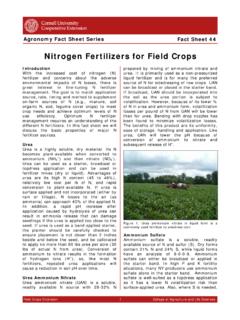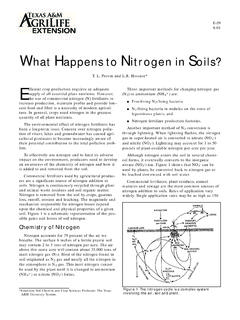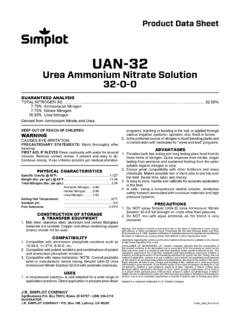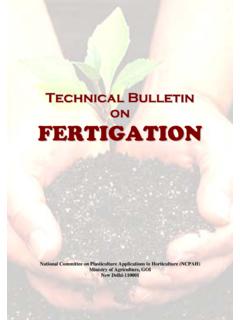Transcription of Drip Fertigation in Horticultural crops
1 drip Fertigation in Horticultural crops G. Sri Krishna, Research Associate, Agricultural Research Station, Utukur, Kadapa - 516003. Mail: Application of Fertilizers to plantation, fruits and vegetable crops , though not uncommon, has not been considered adequately. Recently, Ghose (1999) based on recommended doses of fertilizer for different fruit crops projected the requirement of 826. thousand tons of N, 570 thousand tons of P205 and 115 thousand tons of K20 for the year 2000. Similarly, Singh and Kalloo (1999) projected 744 thousands tons N, 372 thousand tons of P205 and 272 thousand tons of K20 for vegetable crops .
2 Thus, fruits and vegetable together have a potential requirement of million tons of major nutrients. Horticultural crops in national economy Horticultural crops contribute to national income by sharing almost one fifth of the total income from agricultural produce. It is widely recommended that Horticultural crops can play a vital role in competing problems of malnutrition, generating greater employment potential in rural areas and bringing nutritional security. A large variety of fruits, vegetables, flowers, plantation/spices crops , medicinal and aromatic plants, root and tuber crops cover roughly seven percent of the gross cropped area but contribute more than 18-20% gross value of agricultural output.
3 As per the estimate available, the total area under these crops (excluding tea, coffee and rubber) was around 11 million hectares. As per FAO estimates, after China and Brazil, India ranks third largest producer of fruits (excluding melons) in the world, with million tons of production (1997). The country contributes about to the total world's fruit production. Mango, Banana, Citrus, Apple and Guava account for 80% of the total area and production of fruits. Again, after China, India is the largest producer of vegetables. India contributes about % of the world vegetable (including melon) production. Presently, availability of vegetables in India is 130 grams per head per day in comparison to 280 gm recommended by the National Institute of Nutrition.
4 The National Commission on Agriculture (NCA). had set a target of 45 million tons of fruits, 104 million tons of vegetables, 300 million tons of potato, 40 million tons of Cassava, 10 million tons of sweet potato, three million tons of onion, 20 billion coconuts, 60,000 tons of black pepper by 2000 AD (Paroda, 1995). During IX Plan annual growth rate of 7 per cent has been targeted for the fruits and vegetables against per cent for food grain crops . Fertilizer use and quality of Horticultural crops Fertilizers also influence quality of Horticultural crops , particularly colour, shape, size, taste, shelf life and processing characteristics.
5 Fertilizers also influence the 111. physiology of plant and thereby determine the composition of fruits and vegetable produce and the resistance of these plants to environmental stress. Soil and plant analysis Fruit crops because of their deep root remification can take nutrients from deeper soil layers. Therefore, the general soil testing programme in which fertility status of 15. cm soil layer is assessed is not useful for fruit crops . Soil sampling from different layers up to m will provide a better assessment of soil fertility status for fruit crops . Nutrient status of plant leaf is a better indicator of proper plant nutrition.
6 Sampling of the particular plant portion provides better diagnosis of nutrient deficiency in the fruit crops . The plant part to be sampled and other conditions related to their sampling is presented in Table 1. Table 1. Suggested Guidelines for Leaf/Petiole Sampling Crop Plant part to be sampled Age, stage, position & other conditions Apple Recently matured leaf including June 15 to August 15 from Prunear petiole base of current season growth at bloom stage. Banana 20cm2 section of leaf 3rd fully open 3rd fully open leaf leaf blade on both side of midrib in centre of the leaf. Grape Petiole 45 days after pruning at bloom stage opposite to flower cluster.
7 Guava Recently matured leaf 3rd pair in August or December at bloom stage. Citrus Leaves including petiole Selection 5-7 month old terminal, spring cycle leaves of mature trees. Ber Recently matured leaf Middle of the shoot 7-8th from apex. Keep central part of the leaf middle of the shoot at bloom stage. Mango Leaves including petiole Collect 4-7 month old leaves from middle of the shoot. Pineapple Middle one third portion of white Fully developed leaf 'D' leaf 3-4. basal portion of leaf months after planting. Fertigation in Horticultural crops Improvements in fertilizer delivery techniques are sought for two reasons: (i) Application of fertilizer in small doses spread across the entire growing season in an effort to match the crop nutrient requirements, to improve nutrient uptake efficiency, minimize losses, thus to maximize the returns per unit amount of fertilizer.
8 112. Table 2. Nutrient Removal by some Fruits and Vegetable crops (Kg/ha). ---------------------------------------- ---------------------------------------- ------------------- Crop Yield (t/ha) N P205 K20. ---------------------------------------- ---------------------------------------- ------------------- Apple 25 100 45 180. Banana 40 250 60 1000. Citrus 30 100 60 350. Grape 20 170 60 220. Mango 15 100 25 110. Papaya 50 90 25 130. Pineapple 50 185 55 350. Cabbage 70 370 85 480. Carrot 30 125 55 200. Cauliflower 50 250 100 350. Cucumber 40 70 50 120. Egg Plant 60 175 40 300. Okra(bhindi) 20 60 25 90. Onion & Garlic 35 120 50 160.
9 Spinach 25 120 45 200. Tomato 50 140 65 190. ---------------------------------------- ---------------------------------------- ------------------- (ii) minimize nutrient leaching below the root zone, particularly of nitrate form of nitrogen, which can have negative impact on raising its concentration in the groundwater above the maximum contaminant limit that is recommended for drinking water quality. In the case of large spacing planted tree crops , drip or under-the-tree micro sprinklers (micro irrigation) provide an opportunity to irrigate a certain portion of the total planted area, thus contribute to increased water uptake efficiency.
10 Application of fertilizers through irrigation system is referred to an ' Fertigation '. Fertigation through microirrigation system provides a technique of application of water and nutrients to an area of the soil where most of the roots are present to coincide with the timing of nutrient requirement by the trees. Therefore, Fertigation is expected to increase the nutrient uptake efficiency, thereby minimizing leaching losses compared with the application of fertilizer in dry granular form broadcast over a large soil area at less frequent intervals. In addition to the tree response, fruit yield and quality, the changes in groundwater nitrate concentrations impacted by the different fertilizer delivery methods.







